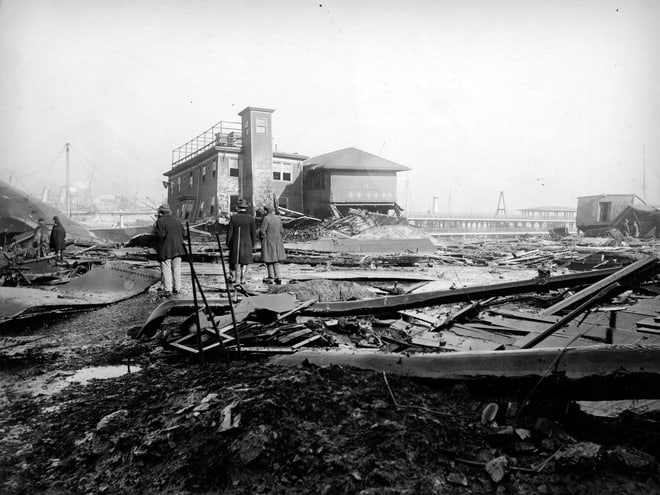The Great Molasses Flood occurred on January 15, 1919, in the North End of Boston. A large molasses storage tank at the Purity Distilling Company burst and a large wave of molasses rushed through the streets at an estimated 35 mph. The disaster killed 21 people and injured 150 others.
The molasses tank, 50 feet tall, 90 feet in diameter, containing as much as 2,300,000 gallons collapsed. The collapse released a wave of molasses 25 feet high. The wave was powerful enough to damage the girders of the Boston Elevated Railway at Atlantic Avenue. Several blocks were flooded to a depth of 2 to three feet.
The first responders to the seen were cadets under the direction of Lieutenant Commander H.J. Copeland from the USS Nantucket training ship. The cadets worked to rescue survivors as well as prevent onlookers from getting too close to the scene. The search for victims lasted for four days.
The local Bostonians sued the United States Industrial Alcohol Company (USIAC), which had bought the Purity Distillery in 1917. Despite the USIAC trying to claim that the tank explosion had been a result of anarchists, the company ultimately paid out $600,000 ($12.6 million) in settlements.
There were sevaral factors that might have contributed to the disaster. The tank was constructed poorly and insufficiently tested. It was so poorly constructed that it had to be painted brown to hide the fact that it had so many leaks. The fermentation occurring within the tank released carbon dioxide with raised the internal pressure. The temperature in Boston rose from 2 degrees to 41 degrees very quickly which also contributed to the increased pressure. An investigation published in 2014 found that the steel was not half as thick as it should have been for a tank of its size.

ADVERTISEMENT - CONTINUE READING BELOW

ADVERTISEMENT - CONTINUE READING BELOW

ADVERTISEMENT - CONTINUE READING BELOW

ADVERTISEMENT - CONTINUE READING BELOW

ADVERTISEMENT - CONTINUE READING BELOW

ADVERTISEMENT - CONTINUE READING BELOW

ADVERTISEMENT - CONTINUE READING BELOW

ADVERTISEMENT - CONTINUE READING BELOW

ADVERTISEMENT - CONTINUE READING BELOW

